C5 Representations of Knowledge
1/23
There's no tags or description
Looks like no tags are added yet.
Name | Mastery | Learn | Test | Matching | Spaced |
|---|
No study sessions yet.
24 Terms
processing information in the mind is just _____
re-presenting; creating representations
nothing in the mind is “real”, everything is a representation
Representation of knowledge: verbal info
after processing a linguistic message, ppl usually retain its meaning, not the exact wording. However, exact wording is remembered if that is the goal.
Wanner 1968: instruction/warning
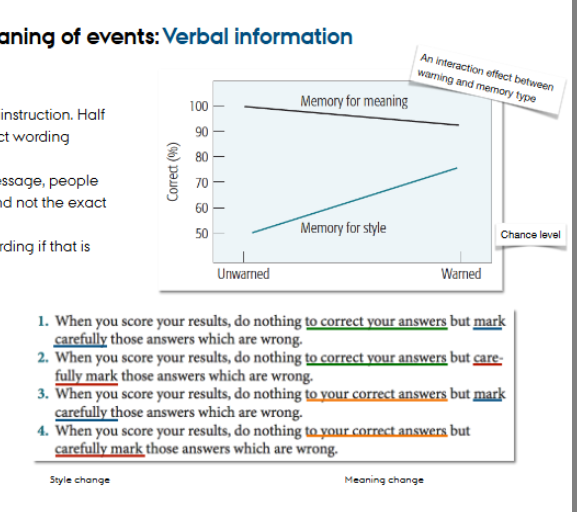
Representation of knowledge: visual info STUDIES
Shepard 1967: memory for pictures (1.5% error rate, nearly perfect) vs memory for verbal material (11.8% error rate)
Brady et al 2008: 2500 images, 12.5% error rate when judging pairs (photo)
Nickerson and Adams 1979: penny, very little detailed memory
Marmie and Healy 2004: ^ unless being told to study the details weeks before the test
Mandler and Ritchey 1977: pictures of diff scenes, type distractors and token distractors (photo) → the meaning of a picture is more memorable than the style

Representation of knowledge: visual info
Visual memory is good when being told to attend to details, but sometimes memory is poor even with objects we see all the time
meaning is more memorable than style
Memory and meaning: STUDIES
Bransford and Johnson 1972: text with or without context (laundry)
Goldstein and Chance 1970: faces vs snowflakes (being distinctly different doesn’t beat being meaningful: 30% memory for snowflakes, 74% for faces)
Oates and Reder 2010: words vs abstract pictures KATO TÄÄ
Bower, Karlin and Dueck 1975: piano playing itself; droodles with (70% memory) and without (51%) meaningful interpretations
main point(s)
easier to remember arbitrary associations when they are converted into something meaningful
meaning over exact details
mnemonic techniques
memory tool
propositional representations
a concept developed to answer the question “what is meant by meaning?”
people who support proposition representation accounts argue that ppl remember a complex sentence as a set of propositions that represent the assertions in the sentence
→ also “true” for pictures: representation is abstracted away from the modality
proposition: smallest unit of knowledge that can stand as a separate assertion (can be judged as true or false)
Kintsch 1974: argues that propositional representations represent meaning as a list containing a relation followed by an order list of arguments
e.g. humans are mortal → [is: humans, mortal]
the ants ate the sweet jelly → [eat: ants, jelly, past], [sweet: jelly]
example of an amodal symbol system
People tend to remember the propositions but not their actual combinations
![<p>a concept developed to answer the question “what is meant by meaning?”</p><p></p><p>people who support proposition representation accounts argue that ppl remember a complex sentence as a set of propositions that represent the assertions in the sentence</p><p>→ also “true” for pictures: representation is abstracted away from the modality</p><p></p><p>proposition: smallest unit of knowledge that can stand as a separate assertion (can be judged as true or false)</p><p></p><p>Kintsch 1974: argues that propositional representations represent meaning as a list containing a<strong> relation</strong> followed by an order list of<strong> arguments</strong> </p><ul><li><p>e.g. humans are mortal → [is: humans, mortal]</p></li><li><p>the ants ate the sweet jelly → [eat: ants, jelly, past], [sweet: jelly]</p></li><li><p><strong>example of an amodal symbol system</strong></p></li></ul><p>People tend to remember the propositions but not their actual combinations</p><p></p>](https://knowt-user-attachments.s3.amazonaws.com/2ef39137-b7da-4d43-bbd7-d9c35d422bb0.png)
amodal symbol system / approach / hypothesis
a system that doesn’t refer to any particular modality; inherently non-perceptual, abstracted from source modality
feature lists, semantic networks
Kintsch 1974: propositional representations
amodal hypothesis of knowledge representation
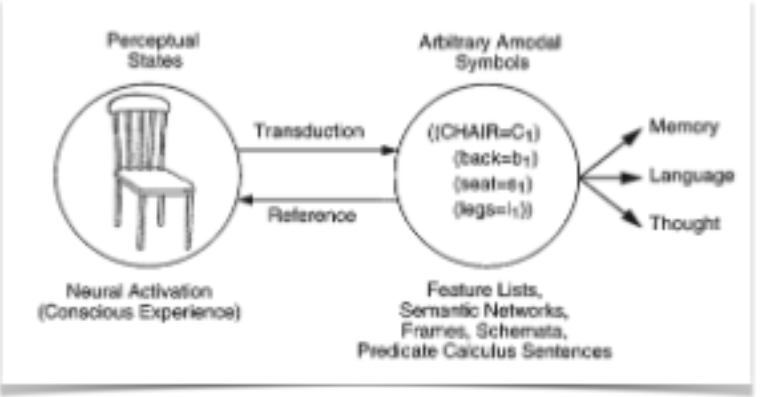
perceptual/modal symbol system
a system where information is represented in modality-specific terms and info is basically perceptual
images, perceptual symbols
Barselou 1999, Stanfield and Zwaan 2009, (Pavio 1971)
embodied cognition

Perceptual symbol systems: evidence, studies
Barselou: when a sentence is understood, one comes up with a perceptual representation of that sentence ;
Stanfield and Zwaan 2009:
participants presented with sentences
(e.g. “he was hammering the nail into a wall“, “the ranger saw the eagle in the sky“) →
asked “does this picture depict an object mentioned?” →
answers were faster when the picture was closer to the assumed mental image/representation participants had formed
(nail horizontal vs vertical, eagle flying vs sitting on branch)
=modal representations facilitated (helpotti, johti) the response
this would not occur if everything was abstracted into amodal language-like propositions
modal/multimodal hypothesis
embodied cognition
a perspective that emphasizes the role of motor behaviour in cognition; “cognition is typically about acting with a physical body in an environment in which the body is immersed”
meaning is represented in the perceptual and motor systems
action verbs and the involvement of motor areas in representation:
Hauk et al 2004: brain activation while listening to verbs that involved the face, arm or leg (lick, pick, kick) → found greater activation in the part of the motor cortex that would activate when doing said action
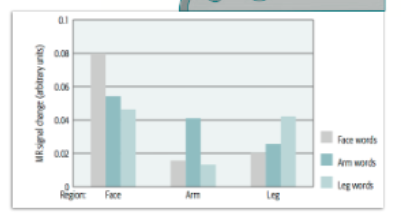
amodal hypothesis of knowledge representation
there is an intermediate abstract system that holds the meaning, which is then converted to modalities (perceptual, motor) and back to abstract

multimodal/modal hypothesis of knowledge representation
knowledge is represented in some modality, and can be converted into another one
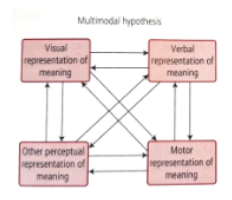
conceptual knowledge - categories
ppl see and represent the world in terms of categories and conceptual structures
→ ppl tend to remember categorical info of an event, not the details
categories are economical, they guide predictions and influence how things are encoded and remembered
however, they can lead to stereotyping (Dunning and Sherman 1997)
Representations of knowledge, other studies
conceptual knowledge, categories: Dunning and Sherman 1997; “Liz/Bob was not very suprised upon receiving her/his math SAT score”
semantic networks
Quillian (1966) proposed that info about categories is stored in a network structure
encode conceptual and propositional knowledge; concepts and their properties
little room for deviation, also semantic networks don’t capture the graded character of categorical knowledge
Collins and Quillian 1969: effects of category level on reaction time (canaries are yellow vs have skin)
→ however, frequency also plays a role (apples are eaten vs apples have black seeds)
Schemas
organize information about a particular topic; used to make inferences about specific instances of the concepts
default values: e.g. offices have a desk and stationery, but not always ovens
schemas don’t demand perfection; category members are simply more (crow) or less (penguin) prototypical
→ degree of membership: more typical members are judged as being members faster
membership/prototypes: binary features (is alive, has wings) and graded features (can fly)
Brewer and Treyens 1981: ppl kept in an office and asked to list items that were there
Rosch (1973, -75, -77)
Labov 1973: typical and atypical cups; degrees of category membership and context dependency (mashed potatoes)
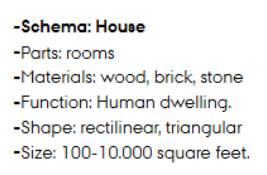
graded character of conceptual/categorical knowledge
some things are worse/better members of a category
Scripts
event concepts
Shank and Abelson 1977: proposed that ppl use these event schemas involving stereotypical sequences of actions
Bower, Black and Turner 1979: people mostly agree on the basic parts of event scripts
Bower et al 1979: new events are encoded with respect to scripts and recalling the events is influenced by the scripts
scripts help with e.g. going to a new airport
abstraction theories
proposes that we abstract general properties from instances we encounter
prototype theory (Anderson): we store a single prototype of a category member and then classify subsequent things in terms of their similarity to the prototype
instance theories
proposes that we store specific instances, and the most frequent ones stand out more (and create general inferences)
exemplar theory (Anderson): we compare the specific instance to other instances and make a judgement based on the difference from the averafe
natural categories
ppl seem to represent biological (living things) categories and artifact (esine) categories in different brain areas
temporal: biological (based on lobe damage)
frontoparietal: artifact (based on lobe damage)
debate: is this about visual vs motor or bio vs artifact? (we tend to look at animals and handle artifacts)
none of these theories are mutually exclusive
that’s right